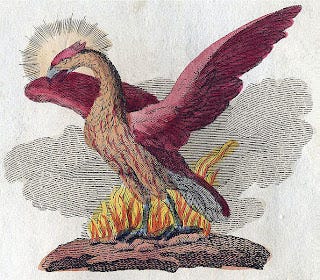“There is a wondrously fair fowl,
strong of feathers, which is called the Phoenix.
Death shall never harm him,
so long as the world remains.”
“The Phoenix” (85-89)
You don’t have to be a professional historian or folklorist to know that the full significance of legends is often grasped only in hindsight. Hints of meaningful patterns become more apparent with distance and perspective.
Take, for example, the legend of the phoenix, a mystical creature which, thanks to the Harry Potter series, has made something of a comeback in the popular imagination.
The phoenix is a marvelously plumed Arabian bird, about the size of an eagle, which periodically bursts into flame, is utterly consumed, and then rises again from its own ashes. For centuries, it’s been a symbol of rebirth or resurrection.
We don’t know quite when or where the phoenix legend originated—many scholars speculate that it comes from ancient Egypt—but the Greek poet Hesiod made mention of the magical bird some 2,600 years ago.1 Other ancient authors, including Herodotus,2 Ovid,3 and Pliny,4 likewise referred to it. In their hands, the legend took on a variety of new details, as legends typically do when they’re passed from one generation or culture to the next.5
What remained constant, though, was the theme of rebirth.
Not surprisingly, early Christians such as Saints Clement of Rome6, Cyril of Alexandria,7 and Ambrose8 saw the phoenix as a symbol of both the resurrected Christ and the promised postmortem resurrection of humans.9 The second-century Christian apologist Tertullian invoked the legend by polemically asking, “Must humans die once for all, while birds in Arabia are sure of a resurrection?”10
Taken by itself, the myth of the phoenix is fascinating enough. But it becomes even more intriguing when one looks back over the course of history and realizes that it’s part of a larger pattern. Legends abound of mythical creatures, humans, and even gods who die only to be reborn. The motif is apparent in stories about Osiris, Ishtar, Persephone, Adonis, Bacchus, and Baldur.11 Comparative mythologists James Frazier and Joseph Campbell convincingly argue that this death-rebirth trope is one of the most common in folklore, epics, and even fairy tales.12 And fascination with the phoenix story appears again and again in literature more rewarding than Rowling’s tales: for example, in the magnificent Old English poem “The Phoenix,”13 in Shakespeare,14 and even in D. H. Lawrence.15
Like a golden thread, then, the hopeful theme of rising from the ashes of death runs deeply through our cultural memory and imagination, forever finding ways to express itself anew.
Now, there are two ways to explain this phenomenon. The first is to presume that it’s nothing more than a psychological coping mechanism to deal with the death fear that’s always hunted humans, and that cultural drift, the slow process by which mythical motifs migrate from one culture to another, has scattered traces of the phoenix legend throughout the world.
According to this way of thinking, the story of the resurrection of Jesus Christ is simply the most recent expression of the death-rebirth mythical pattern. The Christ tale is the latest surfacing of a psycho-historical motif.
But what if the world’s myths of death and rebirth, including the phoenix legend, are historical and cultural stabs at expressing a great truth about reality that, until two thousand years ago, was only vaguely intuited and dimly understood? What if it’s the case that such myths are all imaginative efforts to give voice to a chthonic hardwired realization, one took centuries to reach full consciousness, that death is not the final destiny of humanity—or, for that matter, of creation itself?
If we take this possibility seriously, we can certainly agree with those who say that the resurrection of Jesus Christ is the most recent expression of the ancient phoenix myth. But we can also conclude that it’s a “true myth,” a legend become fact, poetry made real, an event whose inevitability was expressed again and agan in the various cultural manifestations of the death-rebirth motif. That’s precisely what C.S. Lewis, inspired by conversations with J.R.R. Tolkien and Hugo Dyson, concluded:
“Now the story of Christ is simply a true myth: a myth working on us in the same way as the others, but with this tremendous difference that it really happened: and one must be content to accept it in the same way, remembering that it is God’s myth where the others are men’s myths: i.e. the Pagan stories are God expressing Himself through the minds of poets, using such images as He found there, while Christianity is God expressing Himself through what we call ‘real things’.”16
In this view, earlier resurrection images like the phoenix legend are foretellings that point to the great turning-point truth of Christ’s Resurrection, the cosmic renewal commemorated and celebrated at Easter.
When asked for proof of his divinity, Jesus offered the “sign of Jonah”: just as the prophet Jonah had emerged after three dark days in the whale’s belly, so the Messiah would resurrect after three days in the tomb.17
He could just as easily have offered the “sign of the phoenix.”18
Hesiod’s fragment from the “Precepts of Chiron” asserts that the Nymphs, “daughters of Zeus the aegis-holder, outlive ten phoenixes.” The Homeric Hymns and Homerica, trans. Hugh G. Evelyn-White (London: William Heinemann, 1914), p. 75.
Herodotus, The Histories, trans. Tom Holland (New York: Penguin, 2015), p. 138. (Book 2)
Ovid, Metamorphoses, trans. David Raeburn (New York: Penguin, 2004), pp. 612-613. (IV.392-407)
Pliny, Natural History, trans. Philemon Holland (London: George Barclay, 1848), Volume 10, pp. 186-187. (X.2)
A rather dense scholarly overview of the ancient myth is R. Van Den Broek, The Myth of the Phoenix (Leiden: E.J. Brill, 1972). The book’s subtitle, According to Classical and Early Christian Traditions, is a bit misleading, since the bulk of the study focuses on the ancient rather than the early Christian side. More comprehensive and readable is Joseph Nigg, The Phoenix: An Unnatural Biography of a Mythical Beast (Chicago: University of Chicago Press, 2016).
Clement, “First Epistle,” trans. John Keith. In Writings of the Ante-Nicene Fathers, Volume 9 (Peabody, MA: Hendrickson, 1994), pp. 236-237. (Chapters XXV-XXVII)
Cyril of Alexandria, Catechetical Lectures, trans. “Members of the English Church” (Oxford: John Henry Parker, 1839), pp. 243-244. (Lecture XVIII.1-5)
Ambrose of Milan, On the Death of Satyrus. New Advent. (Book II.59-60)
Origen, ever the rationalist, mentions the phoenix, but not as a prototype of Christic Resurrection. Instead, he writes that if the myth is true, it’s an example of God’s wonderful creativity. Origen, Contra Celsum, trans. Henry Chadwick (London: Cambridge University Press, 1953), p. 262. (Book IV.98)
Tertullian, On the Resurrection of the Flesh, trans. Philip Holmes. In Writings of the Ante-Nicene Fathers, Volume 3 (Peabody, MA: Hendrickson, 1994), p. 554. (Chapter XIII)
It goes without saying that Bulfinch’s Mythology is the locus classicus for these kinds of stories. A recent study of the motif worth examining is Paul Rovang, The Archetype of the Dying and Rising God in World Mythology (Lanham, MD: Lexington, 2023).
Shakespeare, Henry the Eighth, Act V, Scene V:
“When
The bird of wonder dies, the maiden phoenix,
Her ashes new create another heir,
As great in admiration as herself.”
D.H. Lawrence, “Phoenix.”
James Frazier, The Golden Bough. Abridged Edition, ed. Theodor H. Gaster (New York: Mentor, 1959), pp. 339-470. Joseph Campbell, The Hero with a Thousand Faces (New York: New World Library, 2008).
Lewis to Arthur Greeves (October 1, 1931). In The Collected Letters of C.S. Lewis, Vol. 1, ed. Walter Hooper (New York: HarperCollins, 2004), pp. 976-977.
This Resurrection prophecy is in Matthew 16:4. In the Lucan 11:29 counterpart, the “sign” is Jesus’s call for repentance, just as Jonah called for the city of Nineveh to repent.
This is a revised version of an essay with the same title in my Faith Matters: Reflections on the Christian Life (Eugene, OR: Cascade, 2019), pp. 212-213.










Delightful! Reminded of Lewis quoting the old “hard-boiled” atheist, a fellow Oxford don, commenting that it was a “rum thing” that the case for the historicity of the Gospels is quite good, as if the dying God myth once actually happened. (Rough paraphrase.) I think it’s in Surprised by Joy, the chapter entitled “Checkmate,” where Lewis describes his reluctantly coming to believe that God was God, knelt and prayed. “The hardness of God is softer than the kindness of men; his compulsion is our liberation,” Lewis concluded. Happy Easter!
Great post. The phoenix gets too little attention, I think. It's an ancient, persistent myth. But if the phoenix may be seen as a "chthonic hardwired realization, one (that) took centuries to reach full consciousness, that death is not the final destiny of humanity," it may also simply be seen as manifestation of mankind's fear of death, it's finality and mystery.